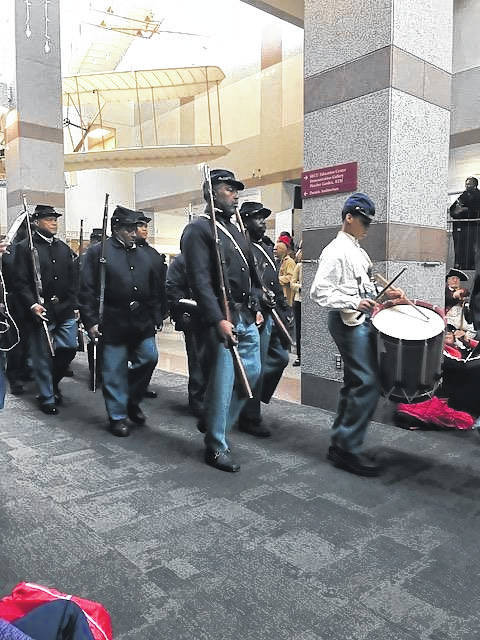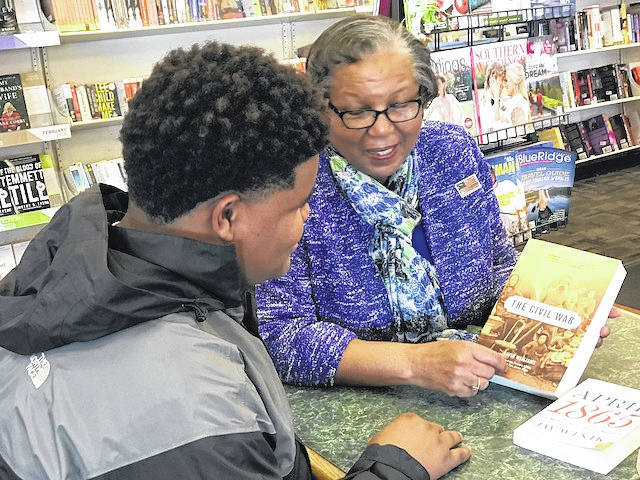LAURINBURG — A group of genealogists and historians are searching for descendants of the 135th USCT, United States Colored Infantry to invite them to take part in a “living History Weekend.”
USCTs were groups of formerly enslaved black and some American Indian men who joined Union Gen. William Tecumseh Sherman’s Army toward the end of the Civil War.
The purpose of contacting the descendants is twofold: to invite them to participate in the event to honor their ancestors and to introduce some to a forebearer they were unaware of, according to Amy Bauer, a retired insurance broker turned genealogist and historian.
Bauer has traced the lineage of a large number of Troop 135 through US Army pension records that she and her husband Jay have traveled to Washington D.C. to examine and has already made contact with a number of descendants.
Many of the people Bauer talked to were unaware that they had an ancestor who fought for the Union in the Civil War.
“My point is to let the descendants understand that they had a relative in the war as a freedom seeker. They left the plantation as a slave and joined the US Army with Sherman’s Troops as volunteer Army with a three year contract just like any other soldier,” Bauer said. “Here they were slaves on a piece of property like the Light-Townsend Plantation [in Marlboro County] and they had their own community, but they left their families and took a chance by joining Sherman’s troops that they were going to get freedom.”
The event has been named The 135th USCT Living History Weekend: The Lost Troop. It will be held on April 6 to 8 in Goldsboro and is free and open to the public.
The living history presentation will be staged along Center Street and include a pop-up museum, exhibits on the war and time period complete with artifacts, encampments with war reenactors will be set up representing the USCT groups 135th, 35th, and 37th, and Battery B group from Fort Fisher in Wilmington will hold cannon demonstrations. There will also be a Civil War medical tent reenactment and a photographer with tintype photography equipment.
Bauer believes events like this are a good way to pique children’s interest in history.
“Bring the kids talk to them about North Carolina and the Civil War some, and when they get bored out of their minds take them to a reenactment. They get to learn about history in a more interactive way,” Bauer said.
During the event an 11 minute video will recount the story of one soldier from the 135th in his own words though pension records and other documents.
There will also be a musical production featuring music of the era and spirituals sung by a 40 person choir.
A representative of the African American Civil War Museum and Foundation in Washington D.C. will be on hand to enroll family members in the Sons and Daughters of the USCTs, a group similar to the Daughters of the American Revolution.
On Saturday, a symposium featuring several historical scholars will take place from 9 a.m. to 3 p.m.
The weekend will end with a banquet held Saturday evening.
USCTs
Many of the USCTs were made up of men from the same county or same area of a state. The 135th was unique because it contained 1,154 men from Georgia, South Carolina and North Carolina, according to Bauer.
Some of those men came from Laurinburg, Maxton, Red Springs, Lumberton and Bennettsville, S.C.
The men joined Sherman’s troops after he completed his “March to the Sea” from Atlanta to Savanah. Sherman turned north heading to Durham to a battle with Confederate General Joseph E. Johnston which led to the largest surrender of the war after 89,000 troops laid down their weapons at Bennett Place.
Before arriving in Durham, Sherman marched through Georgia, South Carolina and North Carolina staying for a time in Scotland County and using Old Laurel Hill Presbyterian as a headquarters before heading to Fayetteville where his 62,000 troops destroyed the Fayetteville Arsenal and fought the battle of Bentonville from March 19 to 21.
The USCTs acted much like modern Navy Seabees do today. They created roads by felling trees and covering them with soil and built bridges that kept Sherman’s army moving.
Sherman’s troops next headed to Goldsboro was where two train lines converged. There he resupplied his troops with Army-issued supplies and rations for the first time since embarking on the March to the Sea. He stayed in Goldsboro from late March to early April of 1865. In Goldsboro, the newly freed members of USCT 135 were allotted uniforms and equipment and mustered their new regiment.
Sherman had planned to join Gen. Ulysses S. Grant in Petersburg, Va. There, Union troops were fighting Gen. Robert E. Lee, but Grant took down Lee’s army leading to surrender of the Army of Northern Virginia in the town of Appomattox Court House on Apr. 9, 1865 and the end of the war.
Following the war, the USCT 135 were used as security forces to guard bridges and hospitals in Kentucky.
USCT 135 was one of few African American troops to ever march in review, along Pennsylvania Avenue for the President of the United States.
“Can you imagine? You were a slave and now here you are marching in front of the President in the Army,” Bauer said.
The N.C. Civil War History & Reconstruction Center of Fayetteville is providing advice and assistance to the USCT 135th celebration and the search.
“The goal of the NC Civil War & Reconstruction History Center in Fayetteville is to create a comprehensive portrait of North Carolina history that spans the Antebellum, Civil War, and Reconstruction periods,” said Marc Barnes public relations contact for the center.
The search and historical event have been made possible with support from the city of Goldsboro, fund raisers and grants.
Anyone who is a descendant or who knows one can reach out to Bauer or Cheri Molter researcher at the N.C. Civil War History and Reconstruction Center at [email protected] or 910-491-0602.
A partial list of local men from USCT 135:
James Brock
Samuel Brown
Stephen Brown
Albert Buoy/Albert McNeil died 1915
Amos Cobb
Jackson Crolley
Aka Jack McNeil
Westley creamery Buffalo soldier
Matthew drake
Flanders Erby
Simon Gibson, died 1917 Gibson
John Gibson
James Gibson
Andrew Gibson
Henry Howe
Charles Johnson
Robert Johnson
Peator Johnson
Henry King
Edward Lane
Caleb Malloy Stewartsville 1880
Daniel Manning
Caesar McCater
Irwin McCarter
Fortune McCarter
Prince McCarter
Jackson McClain
Isaac McLain aka Patterson
Thomas Patterson
Thomas McLaughlin
Neal McMillon
Samuel McMillon
Thomas McMullen
Lewis McNeal
Ramsey McNeal − died in service
Sandy Mc Nair − died Red Springs
Winslow McNair
Harry Murphy
Mansfield Patterson
Washington Powell aka Redick
Benjamin Sellers
Lock Steward
Perry Townsend − Maxton
Benjamin Walker − married Margaret Locklear
Thomas Whitehead


